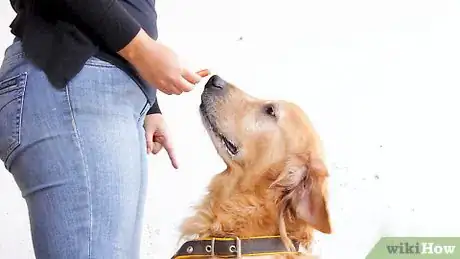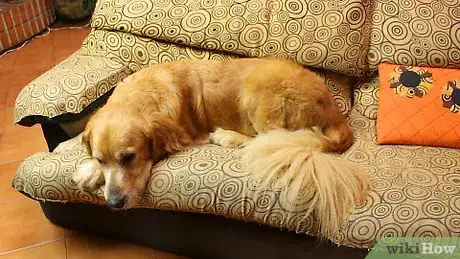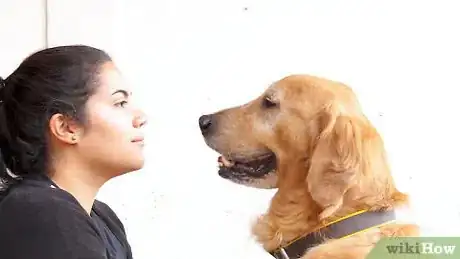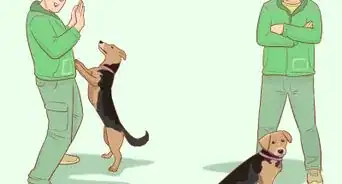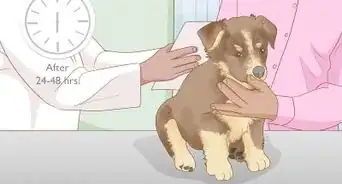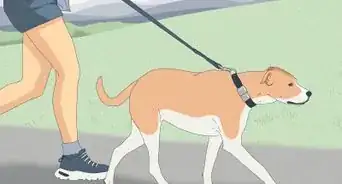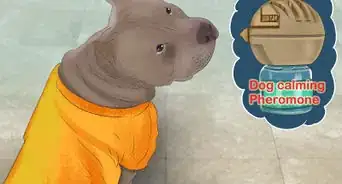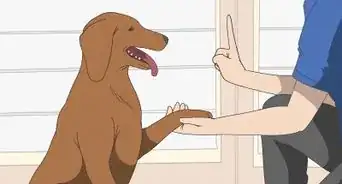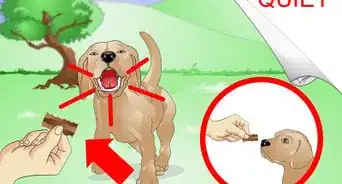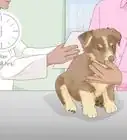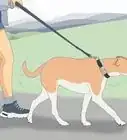This article was co-authored by Toni Woods. Toni Woods is a Professional Dog Trainer in Washington DC. With over 15 years of experience, Toni specializes in improving the relationship between dogs and their families and easing the suffering of dogs experiencing separation anxiety. Toni holds a BS in Biology from Wittenberg University and taught biology for nine years. She now dedicates her life to helping dogs with separation anxiety.
There are 10 references cited in this article, which can be found at the bottom of the page.
This article has been viewed 58,845 times.
Well-behaved dogs know the human is in charge. In order to have a dog who does what you want, you must establish control. There are many positive ways to do this. Never establish control by harming a dog.
Steps
Rewarding the Dog When He or She Listens
-
1Give the dog a treat or other positive reward when the dog does what you want.[1] In this way, you establish to the dog that you’re the boss, and the boss gets to decide whether the dog gets the reward or not.
- Try a food-oriented treat, like a dog bone, a biscuit, or little pieces of cut up hot dog. Figure out which food your dog responds best to because this will vary among animals.
- Some dogs respond more to positive reinforcements that aren’t food, such as toys, a rub to the belly, or a quick walk. Figure out what works for your own dog.
- It’s important not to use negative reinforcements with the dog that could harm the dog. Physical force and cruelty can be illegal, and they also won’t work well with a dog. Dogs respond to love and to reward, not screaming and bullying.
-
2Be very consistent in your rules and rewards.[2] It’s critical that your dog knows what to expect. You can’t expect a dog to see you as being in control if you constantly vary your expectations. Constantly varying rules seems weak to a dog.
- Make sure you’re not the only person in the house following the rules and reward regimen, or the dog will get confused. Don’t give the dog mixed signals.
- You have to be patient and understand it could take some time to train your dog properly. It’s easiest to do when the dog is young, but, either way, it will take some time. Use repetitive commands (like telling the dog to “sit,” and use them several times a day.)
- The dog needs to know there is no “free lunch." The dog should not receive food, for example, before obeying a command. Give the dog clear and consistent structure. [3]
Advertisement -
3Be very firm in both praise and disapproval. Even when praising your dog, let your dog sense your dominance. You can do this by placing your hands firmly on the dog and hugging the dog. Do not praise him in a timid way. Show your strength, kindly.
- The dog should learn to obey you on the first command. If you end up repeating yourself endlessly, the dog will not perceive this as firmness or strength, and you will lose control of the dog.
- Always follow through on commands that you give a dog. If you waver or make exceptions, the dog is going to learn that you aren’t that firm after all. Losing patience and control with the dog actually signals weakness.
Letting the Dog Know You’re the Boss
-
1Make sure the dog knows that his ranking is not at the top of the family pack. Some human behaviors can encourage a dog to think that he’s the alpha in the house.
- Make the dog wait for food after the humans have eaten, and do not feed the dog off the table.[4]
- Control all aspects of the dog’s feeding habits. The dog eats when you say he eats. The dog eats when you release him to eat even a bite. The dog must work to earn his food.[5]
- Control the dog’s toys too. The dog only gets a toy or two out a day, and you choose them. The dog should watch you control the items, putting them away and bringing them out. If the dog tries to guard the toy, the dog loses the toy for a day.
-
2Make the dog move out of your way several times a day. If you are truly the alpha in the situation, you don’t walk around a dog whose big body is snoozing in the hall.
- The dog must treat you like a parent, not a sibling. Remain in control, and calm, but stay dominant. Walk through the dog by gently shuffling your feet until he gets up and moves out of the way.
- Sometimes silence can be most dominating to a dog. Use the verbal commands when you really need them. Be calm at all times.Calmly and silently, stay in command. [6]
- Make sure that you control access to doorways. You are in charge of the house. The dog is not.
- Don't let the dog wildly jump on you when you get home. Greet the dog last, and ignore the dog if the dog jumps up and down.
-
3Do not let the dog assume positions that are higher than you are. This is a way that dogs achieve a sense of power. They should not be on the sofa top, looking down at you, for example. [7]
- This means it’s not a great idea to allow a dog to sleep in your bed. That’s because the dog associates the most comfortable sleeping place with hierarchy. If you must have a dog in bed, make the dog sleep at the foot of your bed rather than, say, on your pillow. Better yet: Give the dog a bed on the floor instead.
- Don’t wrestle with the dog on the floor in a playful manner because the dog will believe the human is equal or lesser if the human is down at its level.[8]
-
4Use the tone of your voice to let the dog know when you disapprove. Dogs don’t necessarily know what human words mean, but they do understand the sounds and tone.[9]
- If you are happy with the dog, let the dog know so by varying the tone of your voice and making your pitch higher. However, when you want to command the dog to do something or indicate your disapproval when the dog doesn’t obey, lower the pitch of your voice.
- Use hand gestures in addition to verbal commands to make your point.
-
5Use eye contact with the dog to establish dominance. Dogs use eye contact to determine who has control. If you avert your gaze first, you lose.
- Averting your gaze will reinforce the dog’s dominance. Do not have staring contests with the dog, though. Just firmly look in the dog’s eyes when you give the dog a command.[10]
- You never want to be in a situation where the dog occupies a higher position than you and you're averting your eyes. That's a recipe for losing control - fast.
Controlling the Dog with Training Techniques
-
1Try leash training with the dog. One way to control a dog is to take the dog for long walks on a leash. Make sure that you establish control this way when you do, or it defeats the purpose.
- Keep the dog on a short leash, and stay ahead of the dog or at its side. You’re the person who leads, not the dog. Don’t let the dog run wildly off leash when it’s not trained, either. The dog has to learn that the human is in charge. Stop the dog several times during walks with commands.
- Try playing “red light, green light” with the dog. Walk the dog on a leash. When the dog runs or walks ahead to the point of pulling at the end of the leash, say red light, and stop completely. Wait. When the dog stops pulling, call him back to you. When he comes back, say, “sit” and give him a treat when he does. Resume walking.[11]
- Use treats to reward your dog for walking beside you and try walking fast. Every few seconds that the dog remains at your side walking, pop a treat in the dog’s mouth. The dog gets no treats if the dog moves too far ahead, to the side, or behind. The dog won’t have as many opportunities to pull away.[12] .
- Do redirection exercises. Training your dog to redirect their attention back to you will show them that you're in charge and can handle whatever situation arises. You can use a command like "watch me," then reward your dog when they look back at you.[13]
-
2Use a crate to train your dog. Choose a crate the dog can stand up and move around in a bit. You can use the crate to reinforce training methods that will show the dog you are in control.[14]
- Put a new toy or treat in the crate, and leave the door open. Wait until the dog goes in the crate to get it. Pet and reward the dog when the dog comes out. Repeat the process. Shut the door to the crate, and don’t open the door until he has been quiet for a few minutes.[15]
- Make a schedule and stick to it. When you open the crate, take the dog outside to go to the bathroom immediately. The dog will learn over time that going to the bathroom is something that can only be done in a certain spot.
-
3Try clicker training on your dog. You can use a small dog clicker to control your dog. You can purchase these at many pet stores. [16]
- The clicker is a small plastic box you hold in your hand. You press it, making a clicking sound, when you want your dog to do something.[17]
- When the dog follows the command, reward the dog with a treat. Eventually, the dog will consider the clicker as almost a language. The dog will learn that following your commands – the click – will result in a positive reward.
-
4Get help from people trained in how to handle dogs. If your dog has become very aggressive and is exhibiting danger signs - like growling or guarding resources - it's critical that you act fast.
- Contact your local veterinarian, and ask for references to credible dog trainers or dog training classes. Know when you need help.
- If the dog is a danger to children or others, you need to contact the Humane Society right away. It's wrong to put others in danger because you can't control your dog.
Expert Q&A
Did you know you can get expert answers for this article?
Unlock expert answers by supporting wikiHow
-
QuestionHow do I get my dog to obey me?
 Toni WoodsToni Woods is a Professional Dog Trainer in Washington DC. With over 15 years of experience, Toni specializes in improving the relationship between dogs and their families and easing the suffering of dogs experiencing separation anxiety. Toni holds a BS in Biology from Wittenberg University and taught biology for nine years. She now dedicates her life to helping dogs with separation anxiety.
Toni WoodsToni Woods is a Professional Dog Trainer in Washington DC. With over 15 years of experience, Toni specializes in improving the relationship between dogs and their families and easing the suffering of dogs experiencing separation anxiety. Toni holds a BS in Biology from Wittenberg University and taught biology for nine years. She now dedicates her life to helping dogs with separation anxiety.
Professional Dog Trainer I suggest using positive reinforcement, which is basically using rewards to teach your dog that what you want them to do is in their best interest. For example, if you want to teach your dog to sit, you would say, "Sit" as soon as they naturally sit down. Then, give them a treat to reinforce the behavior. Over time, your dog will learn that sitting is a good thing!
I suggest using positive reinforcement, which is basically using rewards to teach your dog that what you want them to do is in their best interest. For example, if you want to teach your dog to sit, you would say, "Sit" as soon as they naturally sit down. Then, give them a treat to reinforce the behavior. Over time, your dog will learn that sitting is a good thing! -
QuestionHow do I get dandruff out of my dog's skin? It is really bad.
 Community AnswerPet stores sell dog dandruff shampoo to get rid of dandruff. Wash your dog with the shampoo a couple times a week.
Community AnswerPet stores sell dog dandruff shampoo to get rid of dandruff. Wash your dog with the shampoo a couple times a week. -
QuestionCan a pitbull bite me if I don't give it food?
 Community AnswerYes, it can.
Community AnswerYes, it can.
Warnings
- Your dog may just not understand the commands. If he looks confused when you give him a command, don't scold him. Just keep working with him until he learns the command. You shouldn't punish a dog for not doing something he/she didn't know how to do.⧼thumbs_response⧽
- If dealing with a very aggressive dog, again, you must take action immediately. Call a dog trainer right away by asking for a reference at your local vet. Know when you need help.⧼thumbs_response⧽
References
- ↑ Toni Woods. Professional Dog Trainer. Expert Interview. 11 November 2020.
- ↑ Toni Woods. Professional Dog Trainer. Expert Interview. 11 November 2020.
- ↑ https://www.petfinder.com/dogs/dog-training/dog-dominance/
- ↑ https://www.petfinder.com/dogs/dog-training/dog-dominance/
- ↑ http://specialtydogtraining.com/articles/fifteen-steps-to-becoming-the-pack-leader/
- ↑ http://specialtydogtraining.com/articles/fifteen-steps-to-becoming-the-pack-leader/
- ↑ https://www.aspca.org/pet-care/virtual-pet-behaviorist/dog-behavior/your-dog-dominant
- ↑ http://www.dogbreedinfo.com/topdogrules.htm
- ↑ Toni Woods. Professional Dog Trainer. Expert Interview. 11 November 2020.
- ↑ http://www.dogbreedinfo.com/topdogrules.htm
- ↑ https://www.aspca.org/pet-care/virtual-pet-behaviorist/dog-behavior/teaching-your-dog-not-pull-leash
- ↑ http://www.dogbreedinfo.com/topdogrules.htm
- ↑ Toni Woods. Professional Dog Trainer. Expert Interview. 11 November 2020.
- ↑ http://www.nylabone.com/dog-101/training-behaviors/crate-training/
- ↑ https://www.youtube.com/watch?v=utUXwG7GMoA
- ↑ https://www.youtube.com/watch?v=HPDOrEEsAJ8
- ↑ https://www.aspca.org/pet-care/virtual-pet-behaviorist/clicker-training-your-pet
